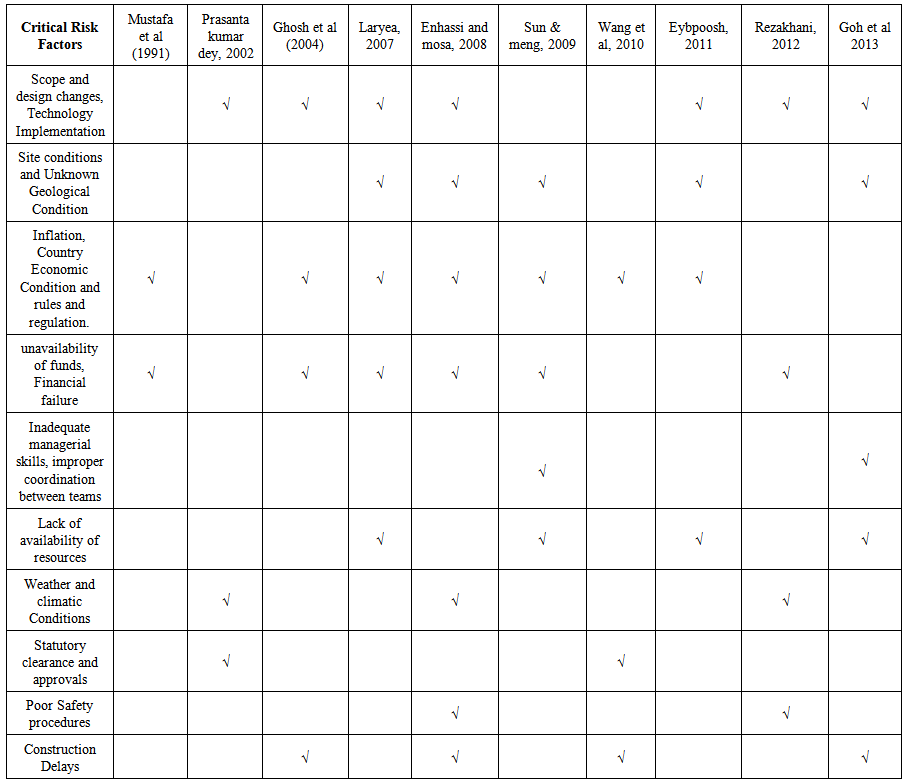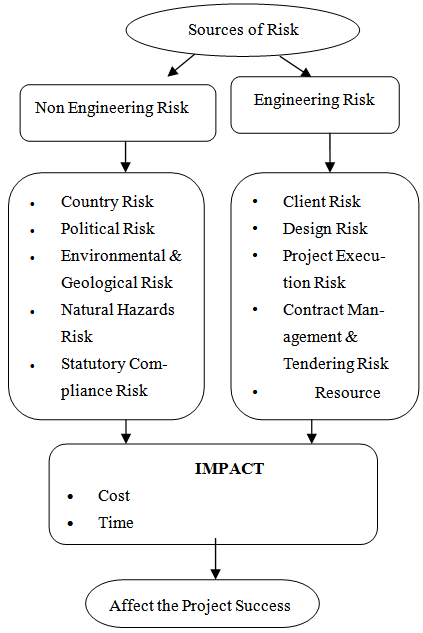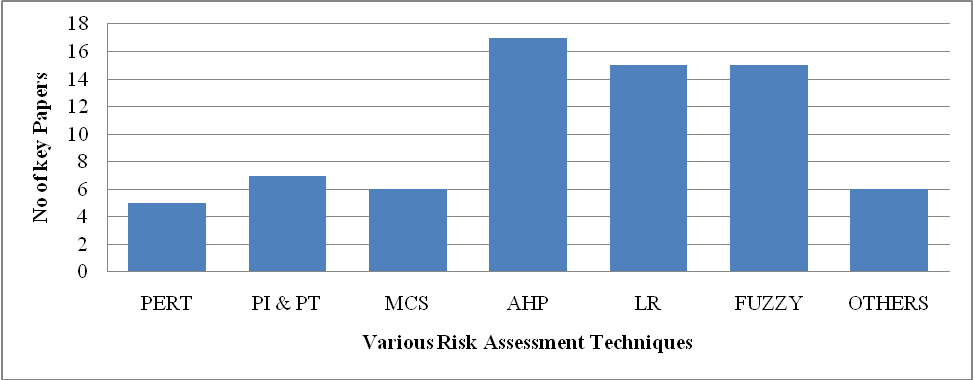-
Paper Information
- Next Paper
- Previous Paper
- Paper Submission
-
Journal Information
- About This Journal
- Editorial Board
- Current Issue
- Archive
- Author Guidelines
- Contact Us
Journal of Civil Engineering Research
p-ISSN: 2163-2316 e-ISSN: 2163-2340
2014; 4(2A): 31-36
doi:10.5923/c.jce.201401.07
A Review on Critical Risk Factors in the Life Cycle of Construction Projects
S. M. Renuka1, C. Umarani2, S. Kamal3
1Research Scholar, Department of Civil Engineering, CEG, Anna University, Chennai-25, India
2Associate Professor, Department of Civil Engineering, CEG, Anna University, Chennai-25, India
3Assistant Professor, Department of Civil Engineering, Annamalai University, Chidambaram, India
Correspondence to: S. M. Renuka, Research Scholar, Department of Civil Engineering, CEG, Anna University, Chennai-25, India.
| Email: |  |
Copyright © 2014 Scientific & Academic Publishing. All Rights Reserved.
In any country, infrastructure development will increase the growth of countries economy and generates the large amount of job opportunities. Hence those projects involve a large amount of investment to carry out. In view of that, if any sort of wastage (either time, resources etc) occurs that would lead to the huge monetary losses. These losses occur due to various risks associated with such mega projects. Consequently, these risks play a crucial role for the completion of project within the time schedule and planned budget. In this connection, this study mainly discusses the critical risk factors and its assessment techniques through comparative study of various international construction projects. About 50 relevant articles published over the last 25 years have been reviewed. The review resulted that a simple analytical tool will be developed for each project task to assess the risk easily and quickly, which will encourage the practitioners to do the risk analysis in their project. This review concluded that the earlier risk identification in the project and assessment during the bidding stage of the construction project will lead to the better estimation of the escalation on cost and time overrun. Such risk assessments help to include in the budget and scheduling for the successful completion of the project.
Keywords: Risk Factors, Risk Assessment Techniques, Construction Projects
Cite this paper: S. M. Renuka, C. Umarani, S. Kamal, A Review on Critical Risk Factors in the Life Cycle of Construction Projects, Journal of Civil Engineering Research, Vol. 4 No. 2A, 2014, pp. 31-36. doi: 10.5923/c.jce.201401.07.
Article Outline
1. Introduction
1.1. Risks in Construction Project
- The construction industry is often considered as a risky business due to its complexity and strategic nature. It incurs a numerous project stakeholders, internal and external factors which will lead to enormous risks. Unfortunately, the construction industry has a poor reputation in risk analysis when compared to other industries (Laryea, 2008). However, No construction project is risk free. Risk can be managed, minimized, shared, transferred, or accepted. It cannot be ignored (Latham 1994). Risk is a multi-facet concept according to (PMI, 2008) Project risk management is the processes concerned with identifying, analyzing, and responding to project risk. In the context of construction industry, it is the likelihood of the occurrence of a definite event or combination of events which occur during the whole process of construction. Construction involves many variables, and it is often difficult to determine cause and effect, dependence and correlations. Hence, those risks play a significant role in decision making and may affect the performance of a project (wiguna and scott, 2005). Risk is exposure to the consequences of uncertainty. As a result, subjective analytical methods that rely on historical information and the experiences of individuals and companies have been used to assess the impact of construction risk and uncertainty. Therefore, Risk assessment is a technique that aims to identify and estimate risks impacted upon by a project.A construction project is plagued with various risks in all the stages of the life cycle of the project are shown in fig 1 (Zhao et al., 2010). Therefore Risk Management should be emphasized in construction project, regardless of the project size to assure the achievement of project objectives (Hwang et al., 2013). Risks have been represented as uncertain future event by construction managers and researchers and so they tried to control systematically through risk management and analysis method since early stage of 1990’s. The purpose of this paper is to review and bring together these previous discussions about risk factors and to provide a comprehensive list of major sources of risk factors in the life cycle of construction projects based on extensive literature study.
 | Figure 1. Life Cycle of the Construction Project |
2. History of Risks Management in Construction Projects
2.1. The 1990’s – Origin of Risk Analysis in Construction Industry
- During 1990s risk factor identification and assessment technique became a hot research topic. Many contractors developed a series of thumb rules to analyze and assess risks. As a result many construction projects failed to achieve their time, cost and quality goals. (Al- Bahar, 1988) The project risks and uncertainties in cost and time can be managed by a systematic approach during estimation stage in order to minimize their effects. This approach involves identifying risk sources, assessing their effects on a project and selecting ways to control them. (Birnie and Yates, 1991). Accordingly, the sources of risk were categorized based on controllable and uncontrollable factors which will lead to cost and time overrun in a project (Akincl, 1998). Based on this result, different risk assessment models have been formulated to analyze and assess project risks during the bidding stage of a construction project (Mustafa and Bahar, 1991). Similarly few attempts were made by the researches like (Tah et al., 1993), (Wirba et al., 1996), (Dawood, 1998) in risk assessment by Probability-Impact assessment (P-I), Fuzzy Set Theory (FST) and Monte Carlo Simulation (MCS).
2.2. The New Millennium- Arrival of New Systematic Approaches
- Till 2000, only few attempts have made on the identification and assessment of risk factors of the construction projects. As a result there was a lack of systematic approaches to identify and manage the risks in construction projects. (Chapman, 2001) grouped risks into four subsets: environment, industry, client and project. (Shen, 2001) categorized them into six groups with the nature of the risks i.e financial, legal, management, market, policy, and political. (Chen et al., 2004) proposed 15 risks affecting project cost and they were grouped under three heads: resource factors, management factors and parent factors. (Dikmen et al., 2007) used influence diagrams to define the factors which have influence on project cost. (Zeng et al., 2007) classified risk factors as human, site, material and equipment factors. In the post 2000’s many researchers made an attempt to propose the limitations and complexity of risk assessment tools such as Analytical hierarchy process (AHP), P-I, FST, MCS and decision support system.
2.3. The Post 2010’s – Development of More Sophisticated Techniques
- There is a sharp increase in the number of risk identification and assessment papers published after 2010. More sophisticated models have been developed by various researchers for integrating the risk assessment in comprehensive decision making frame work. Rezakhani (2012) classified the risk factors under three heads: External, Legal and internal. External risk was sub divided into two subsets: unpredictable / uncontrollable, predictable / uncontrollable and Internal risk was sub divided into two subsets: Non-technical / controllable, Technical / controllable. Further he suggested a hierarchy based risk break down structure and identified the key risk factors. Goh et al (2013) identified 19 risk factors in the life cycle of the project under four heads such as Planning stage, Design stage, Procurement stage, construction stage, Handling over stage. They discussed the use of work shop with an integrated approach which includes brain storming, checklist, probability impact matrices, subjective judgment, and risk register. Finally they suggested that the risk management workshop will be useful for risk identification and analysis, as a means of managing risks. Many researchers have tried various approaches for representing the interdependencies between project risks and its complexity of the surrounding environment (Lazzerini and mkrtchyan, 2011). (Hwang et al., 2013) reported that risk management implementation is relatively low in small construction projects and this is due to lack of time and budget, low profit margin and not economical. The results indicated a positive correlation between RM implementation and improvement in project quality, cost and schedule performance of small projects.
3. Analysis and Discussion on Identification and Assessment of Critical Risk Factors
3.1. Different Types of Risk in Construction Projects
- Risks in construction have been classified in different ways. Tah et al. (1993) categorized project risks into external and internal risks and developed a fuzzy model for contractor’s risk assessment at the tender stage. External risks are those that are prevalent in the external environment of projects, such as those due to inflation, currency exchange rate fluctuations, technology change, major client induced changes, politics, Climate, Weather Condition and major accidents or natural disasters. They are relatively non-controllable and so there is the need to continually scan and forecast these risks and in the context of a company’s strategy. Similarly, internal risks are relatively more controllable and vary between projects. These internal risks cover uncertainties due to labour, plant, material and subcontractor, resources and the site conditions. Consequently many researchers identified several risk factors and they are classified into different types depends on the nature of risk such as Physical, Environmental, design, Financial, Contractual / legal, Construction, Political, Management, Natural hazards, Safety and Delay risk (Mustafa, 1991; Akincl et al., 1998; Prasanta kumar dey, 2002; Ghosh et al., 2004; Wiguna and scott, 2005; Enshasi and mosa, 2008; wang et al., 2010; Razakhani, 2012; Goh et al., 2013).
3.2. Identification of Critical Risk Factors
- The critical risk factors identified by many researches done in different type projects like residential, industrial, commercial, infrastructure etc in various foreign countries are shown in table 1. From the table it is understood that, factors like, Country risk (Inflation, country economic condition), Environmental and geological risk (Weather and climatic conditions), Statutory Compliance Risk (Statutory clearance before planning a project), design risk (scope and design changes), Project Execution risk (new technology implementation, Poor Safety procedures, Construction Delays, Inadequate managerial skills, improper coordination between teams), Resource Risk(Lack of availability of resources) are the critical risk factors in various international projects. From this table it is concluded that, there is an urge for a knowledge map which depicts the sources of critical risk factors and its impact on the successful completion of the construction Project. According knowledge map has been developed and it is discussed below.
 | Table 1. Critical Risk Factors |
3.3. Knowledge Map
- From the review of literature, the major risk sources and their impact are identified. The knowledge map representing the risk sources affecting the project success is shown in figure 2. This flow chart consists of various risk factors, in which Engineering risks are predictable and those non engineering risks are non predictable. The predictable factors should be forecasted during the earlier stage of the project whereas the non predictable factors involve uncertainties; this should also be estimated for the successful completion of the project because these risks will affect the cost, time, quality of the project.
 | Figure 2. Knowledge Map Representing the Risk Sources affecting the Project Success |
3.4. Risk Assessment Techniques
- Recently, a number of systematic models have been proposed for use in the risk evaluation phase of the risk management process. Dey (2002) proposed a quantitative approach through an analytical hierarchy process and decision tree analysis. He argued that the probability models like MCS, FST, P-I required detailed quantitative information which is not normally available at the time of planning and its applicability in real project is also very limited. Thomas et al. (2006) used fault tree to model and assess risk probability and impact. They attempted to improve risk assessments by assessing risk levels of specific risk scenarios. Abdelgawad et al. (2010) explored the RM process using combined fuzzy Failure mode and effect analysis (FMEA) and Fuzzy AHP. These analyses map a relationship between impact and probability of occurrence and detection /control and the level of criticality of risk events to support PM team to establish corrective actions in a timely manner. Eybpoosh et al. (2011) demonstrated the causal relationship between the risk factor using SEM technique. They concluded that the SEM helps decision makers for risk identification and to develop alternative mitigation strategies at the earlier stage of the project. Tamosaitiene et al. (2013) developed a model using TOPIS-F method with fuzzy criteria values to assess risk in construction projects. Using this model risk assessment for three projects was compared with initial fuzzy decision making matrix and solution results were discussed. Laryea and hughes (2010) concluded that the assumptions underpinning analytical models of risk management may not be suitable in practice and why what actually happens in practice is important for those who seek to model the pricing of construction bids.The risk assessment techniques followed by various researches in various literatures is shown in fig 3. The various risk assessment techniques are Project Evaluation and review technique (PERT), Probability and Impact (P&I), Montecarlo simulation (MCS), Analytical Hierarchy process (AHP), Likelihood occurrence of risk (LR), and Fuzzy Logic. Few researches have made an attempt using Analytical neural network (ANN), Bayesian belief Network (BBN). This figure shows that most of the researches have done the risk assessment model in AHP, MCS and LR compared to other techniques. The proposed models carried out using these three techniques have showed good results in assessing the project risk in construction projects. Among different approach models AHP model is more effective, because of its systematic approach to structuring risk assessment problems by providing hierarchical approach. While assessing the project risk at the initial stage of the project, practitioners may not have sufficient data at that time. So it is essential to develop a simple regression model for each project specific task. Moreover, simplicity is a key factor for encouraging professionals to use risk assessment tools in practice.
 | Figure 3. Risk assessment techniques adopted by various researches |
4. Summary and Conclusions
- This paper discussed a review of literatures over past 3 decades on identification and assessment of risk factors in construction project. Almost 1000 international projects from various countries like UK, US, Australia, China, Hong kong, korea, Turkey, Mexico, Malaysia, Thailand etc were considered in this study. It mainly focused on the development of models for assessing the risk factors in construction projects. It also discusses the critical risk factors & its contribution in risk assessment techniques. The findings from the review are presented as table & charts. The table 1 discusses about the critical risk factors identified by researches in various construction projects. Then a knowledge map is developed and it is shown in fig 1. It represents the risk sources in construction project which affect the project success. An extensive literature survey revealed that researchers have shown a remarkable contribution towards risk identification and assessment. It is unfortunate that, there is still a wide gap between theory and practice and so many researchers have been done mostly on developed countries. In India, only few research works have been done in this area. This paper recommends that the risks factors affecting the life cycle of the construction projects needs to be identified. Then a frame work is to be design for quantifying the risk factors considering the uncertainties. It is necessary to develop a simple statistical model for risk assessment in construction projects considering small and medium sized projects also. Finally suitable recommendations are to be suggested, to mitigate the risks during the life cycle of the project to make the project success.
ACKNOWLEDGEMENTS
- This paper presents the preliminary findings of a research project entitled “Identification and assessment of risks in construction projects”, sponsored by Anna Centenary Research Fellowship, Anna university, Chennai, India.
 Abstract
Abstract Reference
Reference Full-Text PDF
Full-Text PDF Full-text HTML
Full-text HTML